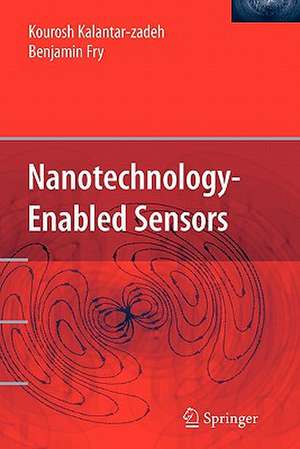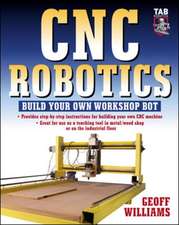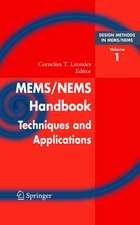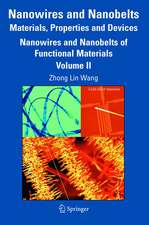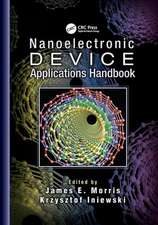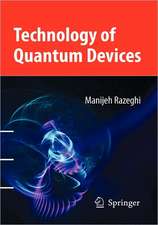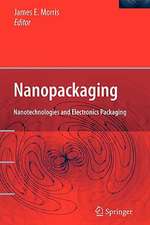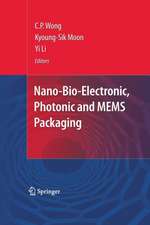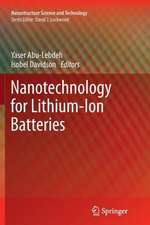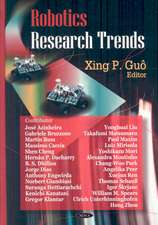Nanotechnology-Enabled Sensors
Autor Kourosh Kalantar-zadeh, Benjamin Fryen Limba Engleză Paperback – 29 oct 2010
| Toate formatele și edițiile | Preț | Express |
|---|---|---|
| Paperback (1) | 707.00 lei 6-8 săpt. | |
| Springer Us – 29 oct 2010 | 707.00 lei 6-8 săpt. | |
| Hardback (1) | 958.56 lei 6-8 săpt. | |
| Springer Us – 31 oct 2007 | 958.56 lei 6-8 săpt. |
Preț: 707.00 lei
Preț vechi: 831.76 lei
-15% Nou
Puncte Express: 1061
Preț estimativ în valută:
135.28€ • 141.26$ • 111.71£
135.28€ • 141.26$ • 111.71£
Carte tipărită la comandă
Livrare economică 15-29 aprilie
Preluare comenzi: 021 569.72.76
Specificații
ISBN-13: 9781441940858
ISBN-10: 1441940855
Pagini: 504
Ilustrații: XII, 492 p. 286 illus.
Dimensiuni: 155 x 235 x 26 mm
Greutate: 0.7 kg
Ediția:Softcover reprint of hardcover 1st ed. 2008
Editura: Springer Us
Colecția Springer
Locul publicării:New York, NY, United States
ISBN-10: 1441940855
Pagini: 504
Ilustrații: XII, 492 p. 286 illus.
Dimensiuni: 155 x 235 x 26 mm
Greutate: 0.7 kg
Ediția:Softcover reprint of hardcover 1st ed. 2008
Editura: Springer Us
Colecția Springer
Locul publicării:New York, NY, United States
Public țintă
ResearchCuprins
Sensor Characteristics and Physical Effects.- Transduction Platforms.- Nano Fabrication and Patterning Techniques.- Characterization Techniques for Nanomaterials.- Inorganic Nanotechnology Enabled Sensors.- Organic Nanotechnology Enabled Sensors.
Recenzii
From the reviews:
"`Nanotechnology-Enabled Sensors' is a textbook giving the reader an introduction to both sensing and nanotechnology ... . focus on broadness of topics without confusing the reader with too many details, and the extensive reference lists at the end of all the chapters, make it a highly appreciable introduction to the field of nanotechnologyenabled sensing. This book is an excellent tool both for graduate students (after bachelor level) and scientists wishing to obtain a good, concise overview of both nanotechnology and sensing ... ." (Peter A. Lieberzeit, Analytical and Bioanalytical Chemistry, Vol. 392, 2008)
"Nanotechnology-Enabled Sensors provides the reader with a deep understanding of the concepts of nanotechnology enabled sensors ... . this book provides a good basis for anyone entering or studying the field of nanotechnology enabled sensors. It not provides a good basis for the inexperienced practitioner but also could be very useful to those with some experience. ... Nanotechnology-Enabled Sensors should be very useful for both: researchers as well as final year graduate and post graduate students ... ." (Sergey Y. Yurish, Sensors & Transducers Journal, Vol. 98 (11), 2008)
"There is currently no textbook that captures the advances in motion during the last decade. The authors have attempted to fill the void with this book … . The book is intended for a general audience with a background in university level physics and chemistry. … The book provides a good introduction to sensors for beginners–the definitions unique to the field, basic theory behind the operation, and transduction platforms are all strong points." (Meyya Meyyappan, IEEE Nanotechnology Magazine, December, 2009)
"`Nanotechnology-Enabled Sensors' is a textbook giving the reader an introduction to both sensing and nanotechnology ... . focus on broadness of topics without confusing the reader with too many details, and the extensive reference lists at the end of all the chapters, make it a highly appreciable introduction to the field of nanotechnologyenabled sensing. This book is an excellent tool both for graduate students (after bachelor level) and scientists wishing to obtain a good, concise overview of both nanotechnology and sensing ... ." (Peter A. Lieberzeit, Analytical and Bioanalytical Chemistry, Vol. 392, 2008)
"Nanotechnology-Enabled Sensors provides the reader with a deep understanding of the concepts of nanotechnology enabled sensors ... . this book provides a good basis for anyone entering or studying the field of nanotechnology enabled sensors. It not provides a good basis for the inexperienced practitioner but also could be very useful to those with some experience. ... Nanotechnology-Enabled Sensors should be very useful for both: researchers as well as final year graduate and post graduate students ... ." (Sergey Y. Yurish, Sensors & Transducers Journal, Vol. 98 (11), 2008)
"There is currently no textbook that captures the advances in motion during the last decade. The authors have attempted to fill the void with this book … . The book is intended for a general audience with a background in university level physics and chemistry. … The book provides a good introduction to sensors for beginners–the definitions unique to the field, basic theory behind the operation, and transduction platforms are all strong points." (Meyya Meyyappan, IEEE Nanotechnology Magazine, December, 2009)
Textul de pe ultima copertă
Nanotechnology provides us with tools to create functional materials, devices, and systems by controlling materials at the atomic and molecular scales, and at the same time make use of novel properties and phenomena. Considering that most chemical and biological sensors, as well as many physical sensors, depend on interactions occurring within the nano scale range, the impact that nanotechnology will have on the sensor world is significant.
Nanotechnology enabled sensors find applications in several novel fields such as sensing single molecules, bio-hazards, toxic chemicals, gas sensors, process control and diagnostics. Application of nanostructured materials for biological applications, biologically assisted nanofabrication, and the development of next-generation of biosensors and biomedical instrumentation for improved sensing is increasingly attracting interests in the scientific community.
Nanotechnology enabled sensors find applications in several novel fields such as sensing single molecules, bio-hazards, toxic chemicals, gas sensors, process control and diagnostics. Application of nanostructured materials for biological applications, biologically assisted nanofabrication, and the development of next-generation of biosensors and biomedical instrumentation for improved sensing is increasingly attracting interests in the scientific community.
Caracteristici
Covers the integration of both nanotechnology and sensors and explains their interaction Geared toward practical applications which provide the reader with information on how nanotechnology enabled sensors are currently being used and how they will be used in the future in diverse fields Provides readers with an overview of the relevant chemistry, quantum physics and biology related to sensors and nanoscience so that they may easily research different topics outside their area of specialization Discusses top down design and manufacturing of nanotechnology sensors, a new approach in sensing technologies Includes supplementary material: sn.pub/extras
